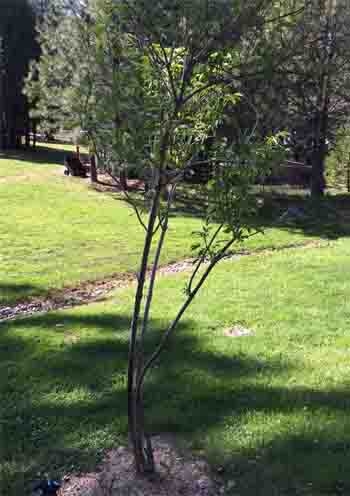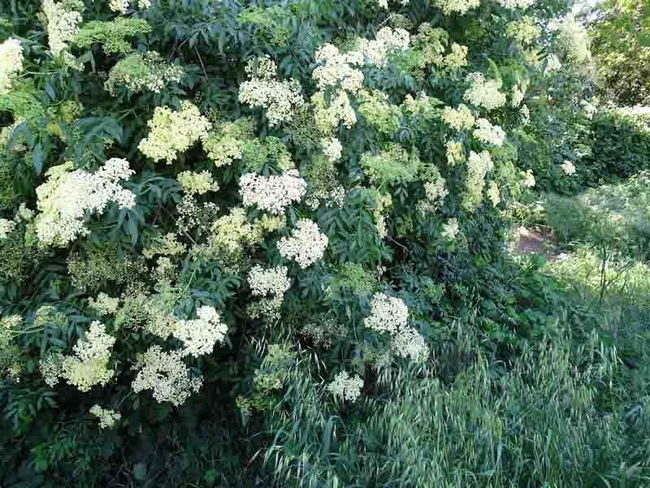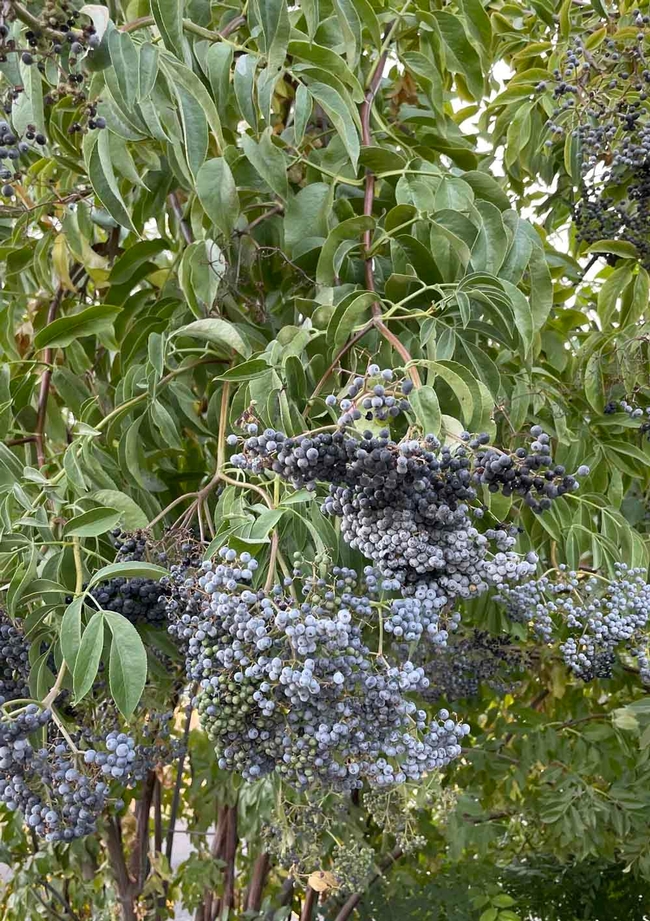Gardeners looking for a drought-tolerant and highly disease-resistant native shrub might consider adding the blue elderberry (Sambucus cerulean also known as Sambucus Mexicana) to their landscape. This species of elderberry is native to the West coast of North America at elevations ranging from sea level to 10,000 feet from Baja to British Columbia. Although it is drought tolerant, it can be considered riparian because it prefers moist locations near rivers or springs. It will also show itself to be particularly thankful for fertile, nitrogen-rich soils.

The elderberry can be identified through its flowers in late spring, and bunches of blueish berries in mid to late-summer. Typically, hundreds of tiny flowers comprise what appears to be one light cream-colored flower in skyward-facing bunches. A waxy coating on the purple berries gives them their blueish finish. Another distinctive characteristic is that the elderberry is among the first shrubs to show green shoots, sometimes in late fall after the first rains and even well before the California buckeye, another early blooming native.
The plant's flowers and berries are valuable for native wildlife. Nearly two dozen moths and butterflies seek the pollen from the fragrant cream-colored elderberry flower. The berries are an important source of food for native birds in California. Once birds eat the berries, they return the favor by helping the plant propagate, spreading the un-digested seeds far and wide.
According to UC Cooperative Extension advisor Rachael Long, the elderberry is one of several natives that provide nectar and pollen for native bees, honey bees, and other insects. “I see a lot of green lace wings (predators of aphids, spider mites and other pests) in elderberry” she notes. The berries are edible for humans if properly prepared. They contain a mild toxin which can easily be cooked out.

The elderberry gets its name from Anglo-Saxon words: “auld” or “ellarn”, meaning fire or kindle, because the hollow branches were used to direct air blown into kindling. Those hollow stems also led to their use as musical instruments, among these the "Sambuke" from which the genus name "Sambucus" was derived.
Elderberry references make cultural appearances spanning space and time. In Greek mythology, the Titan Prometheus presented the gift of fire to man in a hollow elderberry branch. In our own time, it is the elder wand, fashioned in part from elderberry wood, which delivers a decisive blow for good over evil in the final chapter of J.K. Rowling's Harry Potter series.
Blue elderberry grows extensively throughout Butte County, favoring streamside locations. For example, in Chico it can easily be found along Big and Little Chico Creeks and Lindo channel. In places along these waterways, there are nearly unbroken stretches of elderberry thickets. The elderberry's tenacity can be seen in the burn-scar area of Butte Creek canyon, where vigorous elderberry canes are re-emerging in profusion.
Blue Elderberry is the only host plant of the Valley Elderberry Longhorn Beetle (Desmocerus californicus dimorphus), a Federally Threatened species. This beetle's current California Fish & Wildlife Service status is “threatened” due to loss of habitat resulting from conversion of land to agriculture, grazing, and levee construction; competition from non-native species; and loss of land to development for recreational, industrial and urban purposes. The adult beetles eat elderberry leaves and flowers, and the larvae eat the pithy inside of the elderberry stem, where they live for part of their lives. Because of the “threatened” status of the beetle, and the fact that the blue elderberry shrub is its host plant (its habitat, so to speak), the elderberry shrub is protected from being disturbed, destroyed, removed, and even trimmed, if the branches are larger than 1 inch in diameter, since the beetle larvae could potentially be living inside branches of that size or larger. In your yard, the elderberry can be managed by pruning as long as the branches are smaller than 1 inch in diameter. Small elderberry branches are hollow and pithy and fairly easy to cut.
If you have space in your yard for a hardy native shrub that will provide food for beneficial insects and pollinators, consider the elderberry. It's best to enjoy this multi-use shrub in a section of your yard where it will not be disturbed, and where it can grow to its full size (30 feet) without needing to be trimmed or moved.
UC Master Gardeners of Butte County are part of the University of California Cooperative Extension (UCCE) system. To learn more about us and our upcoming events, and for help with gardening in our area visit our website. If you have a gardening question or problem, email the Hotline at mgbutte@ucanr.edu or leave a phone message on our Hotline at 530-552-5812. To speak to a Master Gardener about a gardening issue, or to drop by the MG office during Hotline hours, see the most current information on our Ask Us section of our website.
